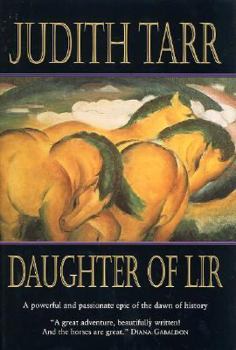Book Overview
In this sequel to "White Mare's Daughter," the people of the horse goddess once more face the threat of war. Generations ago, the people of the White Mare migrated westward, through the great forests, until they met and clashed with the people of the cities of the Mother. They brought war to the cities, but in the end they made peace through alliance and marriage. But now war threatens again. Now there is something rumbling across the plains, coming from the East: a dreadful new weapon wielded by the tribes of the east as they once again begin to push westward. Rhian, a potter's daughter with the gift of seeing, has dreamed of these terrifying war chariots. Emrys, the King's son, has seen them at the edge of his kingdom. Together, they must try to find a way to defend the Cities of the Mothers from a new invasion. Tarr's series of books about the people of the Horse Goddess is a great and powerful saga from the mists of time. The tales she tells are the root of every legend, the heart of every myth. Judith Tarr has created a vividly believable tale of destiny you will never forget.
Format:Hardcover
Language:English
ISBN:0312876165
ISBN13:9780312876166
Release Date:June 2001
Publisher:Forge
Length:416 Pages
Weight:1.60 lbs.
Dimensions:1.3" x 6.4" x 9.6"
Customer Reviews
4 ratings
Well written
Published by Thriftbooks.com User , 15 years ago
Well written novel about the progression from matriarchal to patriarchal society. This book addresses the value of horses to nomadic man.
Brilliant. Ancient epic through modern language.
Published by Thriftbooks.com User , 20 years ago
This is a beautiful book. The second in what seems to be a trilogy, begun with White Mare's Daughter and finished in Lady of Horses, this is set in an ancient eurasian steppe, and travels to the beautiful realm of the goddess worshipers. The setting is described beautifully, the characters are wonderful.. I only wish I could live in Lir.. *sigh* This book made me feel ever more proud to be female. *grin*
Daughter of Lir
Published by Thriftbooks.com User , 21 years ago
Early Celtic mythology and Indo-European history set against a semi-historical Central Asian backdrop. To me, this was one of the best books Tarr's come out with lately. It's not underwritten, it's not boring (it all actually takes place in less than a decade, though only just), and although here and there the plot tries to go in too many directions at once, for the most part it works.Tarr's books are romance novels with action and magic. Relations between men and women, often of different cultures, are central to nearly everything she writes. Readers who don't like this element are advised to stay away from her work--I'm usually not too fond of the romancey subgenres myself. However, she does it well; there's plenty of spice and both the female and male characters have depth and personality, though there's a little too much "war of the genders" phrasing for me. In Daughter of Lir, both Rhian and Minas, the foremost of several pairs in the book, are well-drawn, appealing people.The historical recreation generally works well for me and the horse nomads are great -- I don't know if any actual historical or archaeological evidence supports Tarr's conception, but since it's such early history that doesn't seem indispensable here. I did find it a bit hard to believe that a strongly patriarchal tribe would have a "Year-King" ritual (which apparently is never performed except when the witchy antagonist needs to use it as a threat). Battle scenes are good, though here and there the plot structure gets confusing. The horses are wonderful--sometimes on the verge of being too anthropomorphic, but never sliding over. The fact that the matriarchal society is far from a utopia adds verisimilitude.
A fascinating tale of a turbulent time
Published by Thriftbooks.com User , 23 years ago
The fourth entry into the Epona Sequence, a cycle of books set in the ancient past and focusing on the first cultures to ride and tame horses, may well be the best of them. Set generations after the first novel _White Mare's Daughter_, _Daughter of Lir_ sets the stage with a deftly written prologue filled with signs, portents, and the undercurrent of theological politics. From the story leaps forward to begin to show the many differences -- and interesting similarities -- between the People of the steppes and the cities of the Mother. The main protagonist is a woman, but not far behind are several male characters, who together represent the two opposed cultures.This well-written book keeps a good pace, and Tarr's academic credentials make her depiction of the cultures seem vividly real; even the use of magic (even more clearly an actual working force than in the previous books) seems to fit the novel. Tarr is especially skilled in depicting, with but a few words, deep and complex relationships between individuals without making it seem like vapid romance. Last of all, her style is an impeccably clean prose, not simplistic but simply very clear and unaffected by a desire to seem 'literary'. All in all, the novel was a joy to read.





